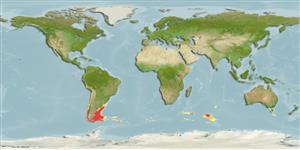Common names from other countries
Environment: milieu / climate zone / depth range / distribution range
Écologie
Pélagique. Temperate; 0°N - 90°S, 180°W - 180°E
Indian Ocean, Southeast Pacific, and Southwest Atlantic: Cephalorhynchus commersonii commersonii: Falkland Islands, Argentina, South Shetland Islands, Chile.
Length at first maturity / Taille / Poids / Âge
Maturity: Lm ? range ? - ? cm Max length : 175 cm TL mâle / non sexé; (Ref. 1394); poids max. publié: 86.0 kg (Ref. 1394)
Found in relatively shallow coastal waters, but move slightly offshore during winter. Feeds on various sepcies of fish, squid and shrimp, near the bottom (Ref. 1394). Found in relatively shallow coastal waters, but move slightly offshore during winter. Feeds on various species of fish, squid and shrimp, near the bottom (Ref. 1394).
Jefferson, T.A., S. Leatherwood and M.A. Webber. 1993. (Ref. 1394)
Statut dans la liste rouge de l'IUCN (Ref. 130435)
statut CITES (Ref. 108899)
Utilisations par l'homme
Pêcheries: commercial
FAO - pêcheries: landings, species profile | FishSource | Sea Around Us
Outils
Plus d'informations
Taille/ÂgeCroissanceLongueur-poidsLongueur-longueurMorphologieLarvesAbondance
Sources Internet
Estimates based on models
Preferred temperature
(Ref.
115969): 6.4 - 13.3, mean 9.4 (based on 356 cells).
Vulnérabilité
Very high vulnerability (90 of 100).
Catégorie de prix
Unknown.
